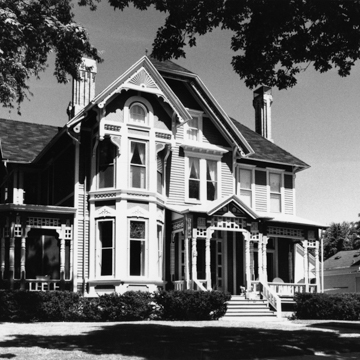Soon after the Winnebagos and Menominees ceded their lands along the Upper Fox River, a surveying crew led by Nathan Strong began laying out a new road from Fond du Lac to Stevens Point. In 1846, at the spot where the route crossed the Fox, Strong and several others established a small settlement. Initially known as Strong’s Landing, then formally platted in 1848 as Strongsville, the town soon took on the official name Berlin. Most of the community’s earliest settlers, however, were not Germans but “Yankees” from New England and upstate New York, who prospered by providing goods and services to area farmers and loggers. Many settled on a steep hill east of the river in what is today called the Nathan Strong Park neighborhood and built residences here in all the fashionable late-nineteenth-century high-style modes.
Some of the finest houses surround a public square, once known as City Park, later as East Side Park, and now as Nathan Strong Park. A classic slice of late-nineteenth-century Americana, it is graced by a statue commemorating Wisconsin’s Civil War veterans and by a charming wooden octagonal band shell, sheltered by a tent roof. Just north of the park, the striking Lucy and Charles Morris House (1882; 209 E. Park Avenue), built by Robert and Elizabeth Holmes, was expanded after the Morrises bought it in 1887. Lucy Morris founded the Wisconsin Federation of Women’s Clubs, helped lead the state’s public library movement, and fought for women’s suffrage. The two-and-a-half-story, clapboard Queen Anne house features a two-story bay window with triangular window heads on the first story, diamond-patterned sills and scrolled brackets on the second, and spindlework and a single round arch at the attic level. The arch ascends the entire height of the bay, framing the center tier of windows and leading the eye up to the elaborate gable, with its geometric bargeboards and sunburst gable brace. Turned-spindle columns border two one-story porches, supporting friezes of oversized geometric cutouts.
The two-story brick Benham-Wright House (c. 1858; 156 N. Adams Avenue) is an outstanding local example of Italianate design. The low-pitched hipped roof has wide-overhanging eaves, supported by pairs of oversized brackets with acorn pendants. This roof configuration recurs in the tall, arcaded belvedere crowning the house. At the ground level, a large double entrance with a semi-elliptical light overhead is flanked by four sets of French doors, two on either side. These open onto a narrow one-story porch, supported by square Tuscan columns. The two-story clapboard Nancy and Charles Hitchcock House (1911; 175 N. Adams Avenue) exemplifies the return to classicism that followed the exuberance of the late Victorian period. The Beaux-Arts classical house boasts a colossal portico with an inset spindle-balustraded balcony. The pediment, punctuated at center by a leaded fanlight, is supported by fluted Ionic columns. Nancy Hitchcock’s mother gave her this house as a wedding gift. An amateur ornithologist, Nancy operated a bird-banding station from this house, working under the direction of the federal Bureau of Biological Survey to record the migratory patterns of songbirds. Her husband, Charles, served as Berlin’s mayor for a dozen years.
Gilbert Rounds’s two-and-a-half-story, cream brick house (1881; 170 N. Wisconsin Street) is Second Empire. The mansard roof creates a roomy attic story. Rich exterior details include scrolled brackets with knobby pendants at the small entrance porch and a thick-bracketed cornice running on each side of the dormer. Rounds owned and managed one of the area’s largest cranberry marshes at a time when the Berlin region’s bogs were widely known. Commercial cultivation around Berlin began in the early 1860s and peaked in the 1870s and early 1880s, just when Rounds built his impressive house. As growers like Rounds repeatedly flooded their fields, seeking to re-create the cranberry’s natural marsh conditions, they leached the soil of the acidity that was vital to the plant’s survival. By the late 1880s, they had largely destroyed their own source of income. Berlin’s brief heyday as a cranberry capital gave way to dairying, the production of leather goods (still significant today), and, in more recent years, tourism.


